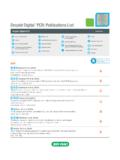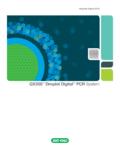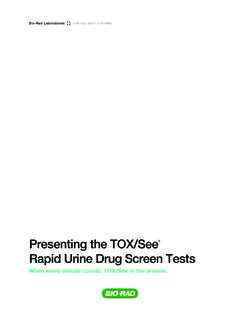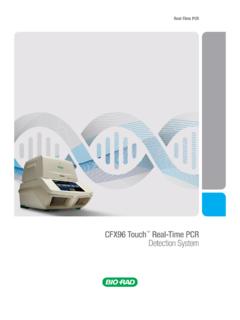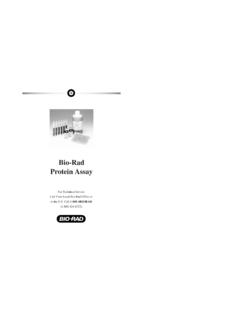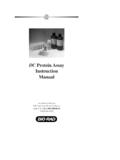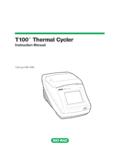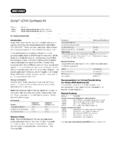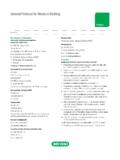Transcription of A Practical Approach to RT-qPCR — Publishing …
1 A Practical Approach to RT-qPCR Publishing Data That Conform to the miqe Guidelines Tech Sean Taylor, Michael Wakem, Greg Dijkman, Marwan Alsarraj, and Marie Nguyen Note Bio-Rad Laboratories, Inc., Hercules, CA 94547. Amplification Bulletin 5859. Introduction The ultimate goal of RDML and miqe is to establish a clear Real-time quantitative PCR ( qpcr ) has become a definitive framework within which to conduct RT-qPCR experiments and technique for quantitating differences in gene expression levels to provide guidelines for reviewers and editors to use in the between samples. Over the past 10 years, the popularity of this evaluation of the technical quality of submitted manuscripts method has grown exponentially, with the publication of well against an established yardstick. As a consequence, investigations over 25,000 papers from diverse fields of science, including that use this widely applied methodology will produce data agricultural, environmental, industrial, and medical research, that are more consistent, more comparable, and ultimately making reference to reverse transcription qpcr ( RT-qPCR ) data.
2 More reliable. Apart from the broad applicability of the technique, one of Given the highly dynamic nature of mRNA transcription and the central factors that has stimulated this impressive growth the potential variables introduced in sample handling and is the increased demand from journal review panels for the in the downstream processing steps (Garson et al. 2009), use of RT-qPCR to support phenotypic observations with a standardized Approach to each step of the RT-qPCR . quantitative, molecular data. Furthermore, gene expression workflow is critical for reliable and reproducible results. The analysis is now being used to support protein expression data miqe provides this Approach with a checklist that contains from proteomics-based assays. The biotechnology industry 85 parameters to ensure quality results that will meet the has responded to the rapid adoption of this technique with acceptance criteria of any journal (Bustin et al.)
3 2009). the concomitant development of reagents and instruments In this paper we demonstrate how to apply the miqe . to perform RT-qPCR experiments. However, since no strict guidelines ( ) to establish a solid guidelines have been established, researchers have generally experimental Approach . designed their experiments based on information gathered from disparate sources, which has resulted in data of variable quality. A number of technical deficiencies can affect RT-qPCR . assay performance, including improper experimental design, inadequate controls and replicates, lack of well-defined experimental conditions and sample handling techniques, poor quality of the RNA sample, suboptimal choice of primers for reverse transcription and qpcr reactions, lack of validation of reference genes, and inappropriate methods of data analysis.
4 In an effort to assist the scientific community in producing consistent, high-quality data from qpcr experiments, the minimum information for publication of quantitative real-time PCR. experiments ( miqe ) guidelines have been recently published (Bustin et al. 2009). This has been followed by the development of an XML-based real-time PCR data markup language (RDML) for the consistent reporting of real-time PCR data by the RDML consortium (Lefever et al. 2009). This consortium is active in the development of appropriate and standardized terminology, guidelines on minimum information for biological and biomedical investigations, and a flexible and universal data file structure with tools to create, process, and validate RDML files. All relevant information about the RDML project is available at A Practical Approach to RT-qPCR Publishing Data That Conform to the miqe Guidelines 1.
5 Experimental Design the RNA sample may lead to inhibition of the RT and PCR. Proper experimental design is the key to any gene expression reaction, yielding biased data. Using partially degraded RNA. study. Since mRNA transcription can be sensitive to external can lead to varying and incorrect quantification results (Fleige stimuli that are unrelated to the processes studied, it is and Pfaffl 2006, Gingrich et al. 2008). Since sample purity and important to work under tightly controlled and well-defined integrity are not related, both should be assessed to ascertain conditions. Taking the time to define experimental procedures, that the RNA sample meets minimal acceptance criteria for the control groups, type and number of replicates, experimental downstream workflow. conditions, and sample handling methods within each group Purity of the sample with respect to protein contamination is essential to minimize variability (Table 1).
6 Each of these can be assessed spectrophotometrically by measuring the parameters should be carefully recorded prior to conducting A 260/280 ratio in a pH neutral buffer. An A260/280 ratio of to gene expression experiments to ensure good biological indicates good quality RNA that is devoid of protein and reproducibility for published data. phenol contamination (Figure 1B). However, no RNA integrity Table 1. RT-qPCR experimental design and sample management. information can be obtained from a spectrophotometric This table summarizes the workflow of a typical RT-qPCR experiment from experimental design to defining control groups, replicates, and experimental reading. RNA integrity can be assessed using several conditions to the detailed procedures for sample handling. This ultimately methods.
7 The traditional method is visual inspection after ensures that the key steps in RT-qPCR data production lead to high-quality, electrophoresis on a formaldehyde agarose gel in the reproducible, publishable data. presence of a fluorescent dye such as ethidium bromide. Experiment Control Experiment Sample Design Groups Replicates Conditions Handling Observation of two sharp bands for the large and the small Disease or Time course Biological Growth Precise time subunit ribosomal RNAs (rRNA) with the intensity of the larger treatment study (different conditions to harvest band being about twice that of the smaller band is indicative of groups ( , t = 0) sample (media and cells or intact RNA. While this method is inexpensive, the interpretation per well) time or tissue absorbance) of the data is mostly subjective and requires approximately Target Normal vs.
8 Technical Days of Sample 200 ng of total RNA, which may be difficult if the sample is genes disease (same sample embryonic extraction only available in limited quantities. This method can be refined implicated ( , normal) per well) development method by quantifying the intensity of the rRNA bands using an imager Potential Untreated vs. Amount per Preservation with densitometry scanning. While the values of the 28S/18S. reference drug treated mass of drug method genes ( , untreated) or compound and time ratio can vary between different tissues or cell types, a ratio Number of Sex, Thaw and between 1 and 2 is indicative of an intact RNA sample. data points phenotype homogenization to draw procedure A major improvement in RNA integrity analysis came with the statistically introduction of microfluidics-based electrophoresis systems significant (Imbeaud et al.)
9 2005) such as the Experion Automated conclusions Electrophoresis System (Bio-Rad) that combines integrity Incubation Total RNA. time extraction and concentration quantification of RNA in a single step from procedure nanogram or picogram quantities (Figures 1A and 1C). In addition to generating a virtual gel, an electropherogram, and calculating 2. RNA Extraction the 28S/18S ratio, the Experion System's software automatically If samples must be collected over a period of time or in calculates and reports an RNA quality indicator (RQI) value too large a number to process immediately, they should be (Figure 1C) that reflects the integrity of the RNA sample based on stored in appropriate conditions (frozen at 80 C and/or in several criteria (Denisov et al. 2008) of the electropherogram. The RNA storage solution) until use.
10 To minimize handling time RQI value ranging from 1 (degraded) to 10 (intact) provides an during the RNA extraction procedure, it is recommended that objective assessment of the integrity of the RNA sample and it samples be processed in relatively small batches of 10 to can be used to screen out degraded samples. 20. The RNA extraction procedure should include a DNase I. By ensuring consistency in both purity and quality across all treatment step to remove any contaminating genomic DNA. RNA samples, variability between biological replicates can be Many commercially available kits such as the Aurum Total reduced (Figure 1D) (Imbeaud et al. 2005). When a batch of RNA Extraction Kits (Bio-Rad Laboratories, Inc.) can be used RNA samples has successfully met the standards of quality for virtually any sample type from plant to animal tissue and control, we recommend their immediate use in RT-qPCR .
